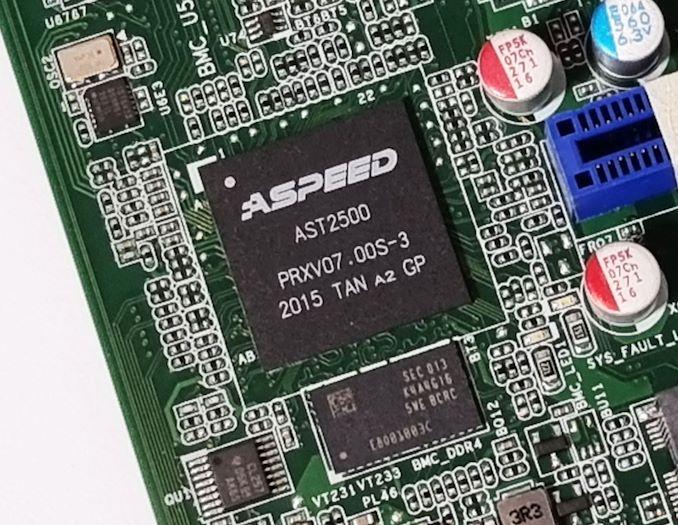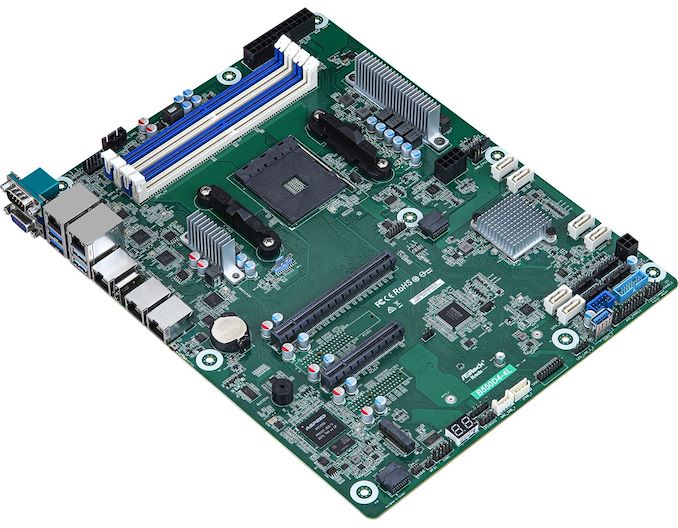ASRock Rack B550D4-4L Motherboard Review: B550 Goes Professional with BMC
by Gavin Bonshor on May 20, 2021 9:00 AM ESTConclusion
Not every motherboard is created equally, nor is every motherboard created with the same functionality as other models. Typically as seen on Intel platforms, it has its consumer-level chipsets such as B560, Z590, Z490, etc, but it also has a level pegged W480 chipset for professional users, which falls outside of its typical industrial level Xeon Scalable platform. Looking at AMD, it doesn't really do this with its desktop platforms, and users looking for workstation-level performance with consumer-level functionality can opt for Threadripper. The other options include Ryzen for desktop, and EPYC for enterprise, cloud, and server, with no real in-between.
When we first got wind of the ASRock Rack B550D4-4L back in January, it piqued our interest as it's the only known board to us that uses AMD's B550 desktop chipset to feature a BMC controller, in this case, an ASPEED AST2500, which is commonly used on professional level boards such as this. Another unique feature of the B550D4-4L is that it has four Intel Gigabit Ethernet ports on the rear, with a fifth designed to provide users access to the board's IPMI, for remote access purposes.
Being on an AMD Ryzen desktop platform, this allows users to use PCIe 4.0, with one full-length PCIe 4.0 x16 slot, and one half-length PCIe 4.0 x4 slot. Typically B550 boards only have one PCIe 4.0 slot, and this is where the B550D4-4L opts for a second PCIe 4.0 slot over a Gen 4 M.2 slot. Instead, the board has one PCIe 3.0 x4 M.2 slot, which supports SATA. As we know, the B550 chipset itself uses PCIe 3.0 lanes, and ASRock Rack is routing this through AMD's modular chipset and tracing to add the second PCIe 4.0 x4 half-length slot. Other storage options include six SATA ports, with four from the chipset with RAID 0, 1, and 10 support, and two via an ASMedia ASM1061 SATA controller.
Functionality and usability are two key parameters to look for in a server-focused model, and the B550D4-4L provides plenty of this, with an intuitive and accessible IMPI interface. We've highlighted that the ASRock Rack IPMI is functional in previous reviews, and the B550D4-4L is no different in this regard. There is also plenty of functionality within the firmware, with B550 specific options including access to AMD Ryzen's Precision Boost Overdrive settings, as well as an LN2 mode, which seems completely out of tune with the board's core values. We really wouldn't recommend overclocking a Ryzen 3000 or 5000 series desktop processor on this board, primarily due to the design of the 4+2 power delivery, and the inadequate heatsinks designed to cool it.

The ASPEED AST2500 BMC chip on the ASRock Rack B550D4-4L motherboard
Focusing on the performance, and the B550D4-4L was surprisingly competitive when compared to other B550 models, not just in our system testing, but in our computational benchmarks too. It has Precision Boot Overdrive (PBO) applied by default, which allowed our Ryzen 7 3700X processor to stretch its legs a little, especially when cooled with our Corsair H150i Elite Capellix 360 mm AIO cooler. The only negative in performance came in our DPC latency testing, with our results showing that this board isn't suitable for DAW systems. In the firmware, we did try setting the same settings as other B550 models on test, but no matter what we inputted in relation to memory settings, the latencies wouldn't change on our memory and resulted in DDR4-3200 with CL22 latencies; this would have a negative impact on general compute performance, but with DDR4-3200 CL16, we would expect it to be highly competitive with other models we've tested.
Final Thoughts
The ASRock Rack B550D4-4L at the time of writing is in a league of its own, with no other AMD B550 series motherboards offering a BMC controller. Another factor to consider here is we haven't been able to find this model anywhere at retail, and we don't have any official MSRP pricing at this time. This makes it tricky, to sum up as it's hard to recommend a model we can't physically get our hands on globally. We do expect the B550D4-4L to be available at retail at some point, and when it eventually is, it offers an interesting professional-level take on AMD's consumer B550 platform.
It keeps up with other B550 in terms of performance which is surprising, but it also has an excellent IPMI interface for easy access and usability. This makes the B550D4-4L one of the most interesting B550 models we've seen so far, especially with four Gigabit Ethernet ports.











73 Comments
View All Comments
YB1064 - Thursday, May 20, 2021 - link
A professional board should have 10GbE ethernet. Period.fmyhr - Thursday, May 20, 2021 - link
Not necessarily. For example, Supermicro builds most of its Xeon E3 boards in multiple flavors: some with multiple 1GbE, some with 10GbE. Evidently there's a market for boards without the built-in 10GbE. Of course you can always add it yourself via PCIe slot. Related: how cool would it be if boards like these had integrated OcuLink ports?beginner99 - Thursday, May 20, 2021 - link
I mean it's not strictly server more workstation/hobbyist focused and 10g has additional costs like the switches etc. I agree however that four 1Gbe ports are nonsensical. Really don't get that. What does oen do with 4 Ethernet ports? What is missing is a middle-ground. 2.5 and 5 gbe capable motherboards. 2x2.5gbe would be completely fine here. You can configure them as needed for fallback or teaming.I just bought a mini-itx board and ran in that issue. You get either 1gbe or 10gbe and the later with at least a $150 additional price tag. 2.5gbe? only found it in some lga1200 xeon-w boards but those don't have a bmc. bummer.
Drkrieger01 - Thursday, May 20, 2021 - link
Four 1Gb NIC ports would be great for a edge router. Add in a 10Gb card if you need a datacenter link, should be great for small enterprise clients (150-500 users). Drop in a Ryzen GE series CPU, and you have a great low power high throughput firewall. The board layout is even great for a 2U chassis, airflow in rack chassis aren't great for traditional ram/CPU position layout.TheinsanegamerN - Thursday, May 20, 2021 - link
The exact smae argument could be made the other way around, one 10GBe port is great for any use case involving high traffic, if you want 4 ports for fallback buy a 4x1Gb card.fmyhr - Thursday, May 20, 2021 - link
I _think_ the reason this motherboard exists at all is that some particular LARGE customer (Facebook?) wanted it. Sure, it would be great to have variations, like Supermicro does for their Xeon E3 boards. But I guess market is not there at the moment to support this... and refusal of AMD to market Ryzen as an E3 competitor isn't helping AT ALL. In the meantime, I'm glad this board... exists? Still can't order one!BedfordTim - Friday, May 21, 2021 - link
You have hit the nail on the head, but the customer is probably smaller. Most of the oddball industrial boards exist for someone's specific purpose.mode_13h - Friday, May 21, 2021 - link
> some particular LARGE customer (Facebook?) wanted it.Not Facebook, given they founded the Open Compute Project, 10 years ago.
Look at ASRock Rack's catalog and you'll see a lot of boards like these.
mode_13h - Friday, May 21, 2021 - link
Speaking of which, their B550D4M model has a OCP 2.0 Mezzanine connector A (PCIe x8).https://www.asrockrack.com/general/productdetail.a...
bananaforscale - Saturday, May 22, 2021 - link
Single 10G says storage server, not "high traffic" in general. Multiple 1G ports are better for security. You know you can just buy that 10G card if you need it?